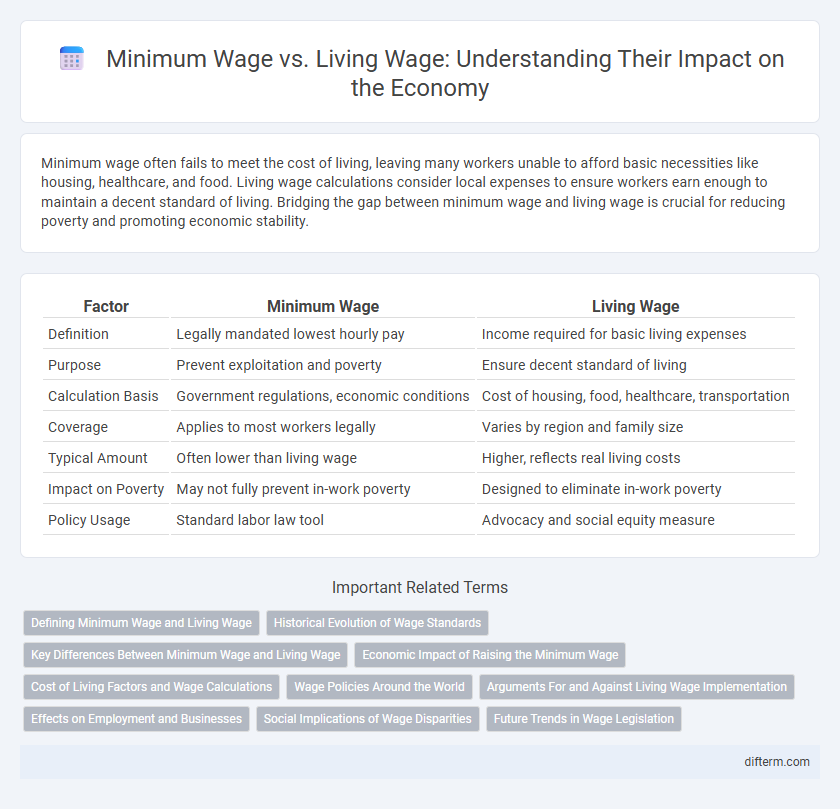Minimum wage often fails to meet the cost of living, leaving many workers unable to afford basic necessities like housing, healthcare, and food. Living wage calculations consider local expenses to ensure workers earn enough to maintain a decent standard of living. Bridging the gap between minimum wage and living wage is crucial for reducing poverty and promoting economic stability.
Table of Comparison
| Factor | Minimum Wage | Living Wage |
|---|---|---|
| Definition | Legally mandated lowest hourly pay | Income required for basic living expenses |
| Purpose | Prevent exploitation and poverty | Ensure decent standard of living |
| Calculation Basis | Government regulations, economic conditions | Cost of housing, food, healthcare, transportation |
| Coverage | Applies to most workers legally | Varies by region and family size |
| Typical Amount | Often lower than living wage | Higher, reflects real living costs |
| Impact on Poverty | May not fully prevent in-work poverty | Designed to eliminate in-work poverty |
| Policy Usage | Standard labor law tool | Advocacy and social equity measure |
Defining Minimum Wage and Living Wage
Minimum wage refers to the legally mandated lowest hourly pay that employers can compensate employees, designed to prevent exploitation and ensure a basic income floor. Living wage represents the income level necessary for workers to meet fundamental needs such as housing, food, healthcare, and transportation within a specific community. The gap between minimum wage and living wage highlights ongoing economic challenges in addressing poverty and ensuring sustainable standards of living.
Historical Evolution of Wage Standards
Minimum wage laws originated in the early 20th century as a response to exploitative labor practices during industrialization, with countries like New Zealand pioneering legislation in 1894 and the United States adopting federal standards by 1938 through the Fair Labor Standards Act. Living wage concepts emerged later, emphasizing wages that meet basic living costs, reflecting shifts in economic conditions and societal expectations since the 1970s, particularly in response to inflation and rising income inequality. The evolution of wage standards highlights the ongoing tension between statutory minimums aimed at poverty alleviation and living wages that seek to ensure economic security and dignity for workers.
Key Differences Between Minimum Wage and Living Wage
Minimum wage is the legally mandated minimum hourly rate employers must pay workers, often set by government regulations to prevent exploitation, while living wage refers to the income necessary for workers to meet basic needs such as housing, food, and healthcare in a specific region. Minimum wage frequently falls below the living wage, leading to workers experiencing financial hardship despite being employed full-time. The key difference lies in minimum wage being a legal standard, whereas living wage is an economic benchmark reflecting real-life costs of sustainable living.
Economic Impact of Raising the Minimum Wage
Raising the minimum wage stimulates consumer spending by increasing the purchasing power of low-income workers, leading to higher demand for goods and services. Businesses may experience increased labor costs, which can result in prices adjustments or shifts in employment patterns, though studies show minimal long-term job losses. Enhanced wages contribute to poverty reduction and lower reliance on social welfare programs, positively impacting overall economic growth and income equality.
Cost of Living Factors and Wage Calculations
Cost of living factors such as housing, healthcare, transportation, and food expenses are critical in determining an accurate living wage, which often exceeds the minimum wage set by law. Minimum wage calculations typically do not account for regional variations or inflation, resulting in a gap between earnings and essential living costs. Incorporating cost of living indices and localized inflation rates into wage calculations ensures more equitable and sustainable income standards.
Wage Policies Around the World
Minimum wage policies vary significantly across countries, with nations like Australia and Luxembourg setting some of the highest statutory wages to ensure basic living standards, whereas others maintain lower thresholds often insufficient for local living costs. Living wage initiatives aim to bridge the gap between legal minimums and actual household expenses, reflecting regional price indices and average income data to promote economic well-being. Comparative analyses highlight that aligning wage policies with living costs can reduce poverty rates and stimulate consumer spending, fostering more resilient national economies.
Arguments For and Against Living Wage Implementation
Implementing a living wage aims to ensure workers earn enough to cover basic living expenses, reducing poverty and boosting consumer spending, which stimulates economic growth. Critics argue it may increase labor costs, leading to reduced hiring, higher unemployment, and inflationary pressure on prices. Balancing these perspectives requires assessing regional cost of living variations and the potential long-term benefits of improved worker productivity and decreased reliance on social welfare programs.
Effects on Employment and Businesses
Minimum wage increases often lead to mixed effects on employment, with some studies showing slight job reductions in low-wage sectors, while others indicate minimal impact due to higher consumer spending. Businesses face higher labor costs, prompting adjustments such as reduced hours, increased prices, or investment in automation to maintain profitability. In contrast, living wage policies aim to improve worker well-being but may further strain small businesses, potentially limiting hiring capacity and slowing business growth.
Social Implications of Wage Disparities
Wage disparities between minimum wage and living wage contribute significantly to social inequality by limiting access to essential services such as healthcare, education, and housing for low-income workers. Insufficient wages exacerbate poverty cycles, increase dependence on social welfare programs, and foster economic insecurity among marginalized populations. Addressing these disparities through wage reforms can improve social cohesion, reduce crime rates, and promote overall community well-being.
Future Trends in Wage Legislation
Future wage legislation is increasingly shifting towards integrating living wage standards to address income disparity and cost of living inflation. Policymakers are considering dynamic wage adjustments tied to regional economic indicators such as housing costs and inflation rates. Emerging legislation trends emphasize sustainability and equity by promoting wages that support worker well-being and economic stability.
Minimum Wage vs Living Wage Infographic

 difterm.com
difterm.com